Radiative Energy Budget for East Asia Based on GK-2A/AMI Observation Data
Abstract
:1. Introduction
2. Materials and Methods
2.1. Geo-KOMPSAT-2A (GK-2A) Data
2.2. ERA5 Sensible and Latent Heat Data
2.3. Equations for Radiative Energy Budget
3. Results and Discussion
3.1. Monthly Variation of Radiative Energy Budget Components for East Asia
3.2. Comparisons of Radiative Energy Budget Components Calculated by GK-2A/AMI and ERA5 for East Asia
3.3. Regional Distribution of Radiative Energy Budget Components for East Asia
3.4. Geographical Characteristics of Radiative Energy Budget Components
| Types of Region | NF_TOA | NF_Sfc | NF_Atm |
|---|---|---|---|
| Mountain | −5.05 ± 0.18 | 10.27 ± 3.33 | −15.32 ± 3.51 |
| Plain | −1.80 ± 0.02 | −4.91 ± 0.10 | 3.11 ± 0.12 |
| Ocean | −9.88 ± 0.09 | −118.26 ± 7.38 | 108.38 ± 7.47 |
4. Conclusions
- Verification of Data: For verification of the GK-2A/AMI radiative products used in this study, they were compared with CERES single scanner footprint (SSF) Level 2 Edition 3A (Ed4A), CERES EBAF, HIMAWARI/AHI, and ERA5 reanalysis data. As a result, the statistical values between GK-2A/AMI and compared data were found to be excellent.
- Variation of Radiative Energy Budget components for East Asia: During the period of this study, among the radiative energy budget components of GK-2A/AMI for East Asia, the monthly mean values of solar radiation components (ISR, RSR, DSR, and SSR) varied with solar zenith angle, and the annual mean albedo at the top of atmosphere was 0.32. However, the variations of monthly mean values for longwave radiation components (OLR, DLR, and ULR) was not distinct, but the net radiative fluxes (NF_TOA, NF_Sfc, and NF_Atm) calculated with non-radiative components (SHF and LHF) for East Asia showed the characteristics of monthly variations, and the annual mean values of their net fluxes were well matched with ERA5 data.
- Regional Characteristics of the Radiative Energy Budget for East Asia: East Asia was characterized by a variety of landcovers and altitude difference. Therefore, in this study, the values of radiative energy budgets were compared for the three regions of mountain, plain, and ocean, with same latitude in East Asia. As a result, the atmospheric net flux (NF_Atm) over mountain region was −15.32 ± 3.51 W·m−2, and it was indicative of a cooling effect in the atmosphere. However, the NF_Atm over plain and ocean regions was 3.11 ± 0.12 W·m−2 and 108.38 ± 7.47 W·m−2, respectively, which played a role in heating up the atmosphere. Therefore, because of the large difference in atmospheric radiative energy accumulated, according to the complex topography of East Asia, the weather pattern changes for this region were significant, and the GK-2A/AMI products could be used as important data for radiative and climatic analysis in this region.
- Application of GK-2A/AMI radiative products: Because the data period (of the GK-2A/AMI) used for this study was limited (one year), the results were insufficient for an accurate radiative energy budget analysis for East Asia. However, since the accuracy of the GK-2A/AMI data used in this study was found comparable to other similar types (Japanese HIMAWARI, and ERA5 reanalysis data), if this is accumulated over several years, it could be very useful for more detailed weather and climate research of East Asia.
Author Contributions
Funding
Data Availability Statement
Acknowledgments
Conflicts of Interest
References
- Huang, B.; Banzon, V.F.; Freeman, E.; Lawrimore, J.; Liu, W.; Peterson, T.C.; Smith, T.M.; Thorne, P.W.; Woodruff, S.D.; Zhang, H.M. Extended reconstructed sea surface temperature version 4 (ERSST.v4). Part I: Upgrades and intercomparisons. J. Clim. 2015, 28, 911–930. [Google Scholar] [CrossRef] [Green Version]
- Vose, R.S.; Arndt, D.; Banzon, V.F.; Easterling, D.R.; Gleason, B.; Huang, B.; Kearns, E.; Lawrimore, J.H.; Menne, M.J.; Peterson, T.C.; et al. NOAA’s merged land-ocean surface temperature analysis. Bull. Am. Meteorol. Soc. 2012, 93, 1677–1685. [Google Scholar] [CrossRef]
- Hansen, J.; Sato, M.; Ruedy, R.; Lo, K.; Lea, D.W.; Medina-Elizade, M. Global temperature change. Proc. Natl. Acad. Sci. USA 2006, 103, 14288–14293. [Google Scholar] [CrossRef] [PubMed] [Green Version]
- Mears, C.A.; Wentz, F.J. Sensitivity of satellite-derived tropospheric temperature trends to the diurnal cycle adjustment. J. Clim. 2016, 29, 3629–3646. [Google Scholar] [CrossRef]
- Spencer, R.W.; Christy, J.R.; Braswell, W.D. UAH version 6 global satellite temperature products: Methodology and results. Asia Pac. J. Atmos. Sci. 2017, 53, 121–130. [Google Scholar] [CrossRef]
- Wuebbles, D.J.; Fahey, D.J.; Hibbard, K.A.; Dokken, D.J.; Stewart, B.C.; Maycock, T.K. Climate Science Special Report: Forth National Climate Assessment Volume I; USGCRP (U.S. Global Change Research Program), Ed.; Cambridge University Press: Cambridge, UK, 2017. [Google Scholar] [CrossRef] [Green Version]
- Menne, M.J.; Williams, C.N.; Gleason, B.E.; Rennie, J.; Lawrimore, J.H. The global historical climate network monthly temperature dataset, version 4. J. Clim. 2018, 31, 9835–9854. [Google Scholar] [CrossRef]
- Adler, R.; Sapiano, M.; Huffman, G.; Wang, J.; Gu, G.; Bolvin, D.; Chiu, L.; Schneider, U.; Becker, A.; Nelkin, E.; et al. The global precipitation climatology project (GPCP) monthly analysis (new version 2.3) and a review of 2017 global precipitation. Atmosphere 2018, 9, 138. [Google Scholar] [CrossRef] [Green Version]
- Masson-Delmotte, V.; Zhai, P.; Pörtner, H.O.; Roberts, D.; Skea, J.; Shukla, P.R.; Pirani, A.; Moufouma-Okia, W.; Péan, C.; Pidcock, R.; et al. Global Warming of 1.5 °C: A Special Report on the Impacts of Global Warming of 1.5 °C above Pre-industrial Levels and Related Global Greenhouse Gas Emission Pathways, in the Context of Strengthening the Global Response to the Threat of Climate Change, Sustainable Development, and Efforts to Eradicate Poverty; IPCC (Intergovernmental Panel on Climate Change), Ed.; Cambridge University Press: Cambridge, UK; New York, NY, USA, 2018. [Google Scholar]
- Barkstrom, B.R.; Harrison, E.F.; Lee, R.B., III. Earth radiation budget experiment. EOS 1990, 71, 297–305. [Google Scholar] [CrossRef]
- Wielicki, B.A.; Barkstrom, B.R.; Harrison, E.F.; Lee, R.B.; Smith, G.L.; Cooper, J.E. Clouds and the Earth’s radiation energy system (CERES): An Earth observing system experiment. Bull. Am. Meteorol. Soc. 1996, 77, 853–868. [Google Scholar] [CrossRef]
- Wild, M.; Roeckner, E. Radiative fluxes in ECHAM5. J. Clim. 2006, 19, 3792–3809. [Google Scholar] [CrossRef] [Green Version]
- Wild, M.; Ohmura, A.; Gilgen, H.; Roeckner, E. Validation of general-circulation model radiative fluxes using surface observations. J. Clim. 1998, 8, 1309–1324. [Google Scholar] [CrossRef]
- Stephens, G.L.; Li, J.L.; Wild, M.; Clayson, C.A.; Loeb, N.; Kato, S.; L’Ecuyer, T.; Stackhouse, P.W.; Lebsock, M.; Andrews, T. An update on Earth’s energy balance in light of the latest global observations. Nat. Geosic. 2012, 5, 691–696. [Google Scholar] [CrossRef]
- Masson-Delmotte, V.; Zhai, P.; Pirani, A.; Connors, S.L.; Péan, C.; Berger, S.; Caud, N.; Chen, Y.; Gomis, M.I.; Huang, M.; et al. Climate Change 2021: The Physical Science Basis: Contribution of Working Group I to the Sixth Assessment Report of the Intergovernmental Panel on Climate Change; IPCC (Intergovernmental Panel on Climate Change), Ed.; Cambridge University Press: Cambridge, UK, 2021. [Google Scholar]
- Eyring, V.; Bony, S.; Meehl, G.A.; Senior, C.A.; Stevens, B.; Stouffer, R.J.; Taylor, K.E. Overview of the coupled model intercomparison project phase 6 (CMIP6) experimental design and organization. Geosci. Model Dev. 2016, 9, 1937–1958. [Google Scholar] [CrossRef] [Green Version]
- Wild, M. The global energy balance as represented in CMIP6 climate models. Clim. Dyn. 2020, 55, 553–577. [Google Scholar] [CrossRef] [PubMed]
- Kato, S.; Rose, F.G.; Rutan, D.A.; Thorsen, T.J.; Loeb, N.G.; Doelling, D.R.; Huang, X.; Smith, W.L.; Su, W.Y. Surface irradiances of edition 4.0 cloud and the Earth’s radiant energy system (CERES) energy balanced and filled (EBAF) data product. J. Clim. 2018, 31, 4501–4527. [Google Scholar] [CrossRef]
- Wild, M.; Hakuba, M.Z.; Folini, D.; Dorig-Ott, P.; Schar, C.; Kato, S.; Long, C.N. The cloud-free global energy balance and inferred cloud radiative effects: An assessment based on direct observations and climate models. Clim. Dyn. 2019, 52, 4787–4812. [Google Scholar] [CrossRef] [PubMed] [Green Version]
- Hersbach, H.; Dee, D. ERA5 Reanalysis is in Production; European Centre for Medium-Range Weather Forecasts: Reading, UK, 2020; p. 147. [Google Scholar]
- European Centre for Medium-Range Weather Forecasts. IFS Documentation; European Centre for Medium-Range Weather Forecasts: Reading, UK, 2016; VY41R2, Part IV. [Google Scholar]
- Giri, C.; Zhu, Z.; Reed, B. A comparative analysis of the global land cover 2000 and MODIS land cover data sets. Remote Sens. Environ. 2005, 94, 123–132. [Google Scholar] [CrossRef]
- Kim, D.; Gu, M.; Oh, T.H.; Kim, E.K.; Yang, H.J. Introduction of the advanced meteorological imager of Geo-Kompsat-2a: In-orbit tests and performance validation. Remote. Sens. 2021, 13, 1303. [Google Scholar] [CrossRef]
- NMSC (National Meteorological Satellite Center). Information/GK2A. Available online: https://nmsc.kma.go.kr/enhome/html/base/cmm/selectPage.do?page=satellite.gk2a.intro (accessed on 1 February 2023).
- Chung, S.R.; Ahn, M.H.; Han, K.S.; Lee, K.T.; Shin, D.B. Meteorological products of Geo-KOMPSAT 2A (GK2A) satellite. Asia Pac. J. Atmos. Sci. 2020, 56, 185. [Google Scholar] [CrossRef] [Green Version]
- Prsa, A.L.; Harmanec, P.; Torres, G.; Mamajek, E.; Asplund, M.; Capitaine, N.; Christensen-Dalsgaard, J.; Depagne, E.; Haberreiter, M.; Hekker, S.; et al. Nominal values for selected solar and planetary quantities: IAU 2015 resolution B3. Astrom. J. 2016, 152, 41. [Google Scholar] [CrossRef]
- Lee, S.H.; Kim, B.Y.; Lee, K.T.; Zo, I.S.; Jung, H.S.; Rim, S.H. Retrieval of reflected shortwave radiation at the top of the atmosphere using Himawari-8/AHI data. Remote Sens. 2018, 10, 213. [Google Scholar] [CrossRef] [Green Version]
- Lee, S.H.; Lee, K.T.; Kim, B.Y.; Zo, I.S.; Jung, H.S.; Rim, S.H. Retrieval algorithm for broadband albedo at the top of the atmosphere. Asia Pac. J. Atmos. Sci. 2018, 54, 165–178. [Google Scholar] [CrossRef]
- Ricchiazzi, P.; Ynag, S.; Gautier, C.; Sowle, D. SBDART: A research and teaching software tool for plane-parallel radiative transfer in the earth’s atmosphere. Bull. Am. Meteorol. Soc. 1998, 79, 2101–2114. [Google Scholar] [CrossRef]
- Kim, B.Y.; Lee, K.T. Radiation component calculation and energy budget analysis for the Korean Peninsula Region. Remote Sens. 2018, 10, 1147. [Google Scholar] [CrossRef] [Green Version]
- Lee, K.S.; Chung, S.R.; Lee, C.; Seo, M.; Choi, S.; Seong, N.H.; Jin, D.; Kang, M.; Yeom, J.M.; Roujean, J.L.; et al. Development of land surface albedo algorithm for the GK-2A/AMI instrument. Remote Sens. 2020, 12, 2500. [Google Scholar] [CrossRef]
- Vardavas, I.M.; Koutoulaki, K. A model for the solar radiation budget of the northern hemisphere: Comparison with Earth radiation budget experiment data. J. Geophys. Res. 1995, 100, 7303–7314. [Google Scholar] [CrossRef]
- Kim, B.Y.; Lee, K.T.; Jee, J.B.; Zo, I.S. Retrieval of outgoing longwave radiation at top-of-atmosphere using Himawari-8 AHI data. Remote Sens. Environ. 2018, 204, 498–508. [Google Scholar] [CrossRef]
- Kim, B.Y.; Lee, K.T. Using the Himawari-8 AHI multi-channel to improve the calculation accuracy of outgoing longwave radiation at the top of the atmosphere. Remote Sens. 2019, 11, 589. [Google Scholar] [CrossRef] [Green Version]
- Ahn, S.H.; Lee, K.T.; Rim, S.H.; Zo, I.S.; Kim, B.Y. Surface downward longwave radiation retrieval algorithm for GEO-KOMPSAT-2A/AMI. Asia Pac. J. Atmos. Sci. 2018, 54, 237–251. [Google Scholar] [CrossRef]
- Jung, H.S.; Lee, K.T.; Zo, I.S. Calculation algorithm of upward longwave radiation based on surface types. Asia Pac. J. Atmos. Sci. 2020, 56, 297–306. [Google Scholar] [CrossRef]
- Choi, Y.Y.; Suh, M.S. Development of a land surface temperature retrieval algorithm from GK2A/AMI. Remote Sens. 2020, 12, 3050. [Google Scholar] [CrossRef]
- Ahn, J.; Lee, Y. Outlier detection and gap-filling of the GK2A daily sea surface temperature (SST) product using statistical methods. J. Clim. Res. 2021, 16, 327–346, (In Korean with English Abstract). [Google Scholar]
- Ellingson, R.G.; Lee, H.T.; Yanuk, D.; Gruber, A. Validation of a technique for estimating outgoing longwave radiation from HIRS radiance observations. J. Atmos. Ocean. Technol. 1994, 11, 357–365. [Google Scholar] [CrossRef]
- Ba, M.B.; Ellingson, R.G.; Gruber, A. Validation of a technique for estimating OLR with the GOES sounder. J. Atmos. Ocean Technol. 2003, 20, 79–89. [Google Scholar] [CrossRef]
- Park, M.S.; Ho, C.H.; Cho, H.; Choi, Y.S. Retrieval of outgoing longwave radiation from COMS narrowband infrared imagery. Adv. Atmos. Sci. 2015, 32, 375–388. [Google Scholar] [CrossRef]
- Ohmura, A.; Dutton, E.G.; Forgan, B.; Frohlich, C.; Gilgen, H.; Hegner, H.; Heimo, A.; Konig-Langlo, G.; McArthur, B.; Muller, G.; et al. Baseline surface radiation network (BSRN/WCRP): New precision radiometry for climate research. Bull. Am. Meteorol. Soc. 1998, 79, 2115–2136. [Google Scholar] [CrossRef]
- Driemel, A.; Augustine, J.A.; Behrens, K.; Colle, S.; Cox, C.; Cuevas-Agullo, E.; Denn, F.M.; Duprat, T.; Fukuda, M.; Grobe, H.; et al. Baseline surface radiation network (BSRN): Structure and data description (1992–2017). Earth Syst. Sci. Data. 2018, 10, 1491–1501. [Google Scholar] [CrossRef] [Green Version]
- Gelaro, R.; McCarty, W.; Suarez, M.J.; Todling, R.; Molod, A.; Takacs, L.; Randles, C.A.; Darmenov, A.; Bosilovich, M.G.; Reichle, R.; et al. MERRA-2 overview: The modern-era retrospective analysis for research and applications, version 2 (MERRA-2). J. Clim. 2017, 30, 5419–5454. [Google Scholar] [CrossRef] [PubMed]
- Jourdier, B. Evaluation of ERA5, MERRA-2, COSMO-REA6, NEWA and AROME to simulate wind power production over France. Adv. Sci. Res. 2020, 17, 63–77. [Google Scholar] [CrossRef]
- Tarek, M.; Brissette, F.P.; Arsenault, R. Evaluation of the ERA5 reanalysis as a potential reference dataset for hydrological modelling over North America. Hybrol. Earth Syst. Sci. 2020, 24, 2527–2544. [Google Scholar] [CrossRef]
- C3S—Copernicus Climate Change Service. ERA5: Fifth Generation of ECMWF Atmospheric Reanalysis of the Global Climate. Copernicus Climate Change Service Climate Data Store (CDS). 2017. Available online: https://doi.org/10.24381/cds.adbb2d47 (accessed on 1 February 2023).
- Chang, J.H. Global distribution of net radiation according to a new formula. Ann. Am. Assoc. Geogr. 1970, 60, 340–351. [Google Scholar] [CrossRef]
- Valizadeh Kamran, K.; Maham, A.; Jafarizadeh, M.; Ghahremani, M. Calculation of the net radiation flux entering the earth using satellite images. Int. J. Rev. Life. Sci. 2015, 5, 606–610. [Google Scholar]
- Schwarz, M.; Folini, D.; Yang, S.; Allan, R.P.; Wild, M. Changes in atmospheric shortwave absorption as important driver of dimming and brightening. Nature Geosci. 2020, 13, 110–115. [Google Scholar] [CrossRef]
- Sim, J.E.; Shin, H.R.; Hirise, N. Comparative analysis of surface heat flux in the East Asian marginal seas and its acquired combination data. J. Korean Earth Sci. Soc. 2018, 39, 1–22. [Google Scholar] [CrossRef]
- Robertson, F.R.; Bosilovich, M.G.; Chen, J.; Miller, T.L. The effect of satellite observing system changes on MERRA water and energy fluxes. J. Clim. 2011, 24, 5197–5217. [Google Scholar] [CrossRef] [Green Version]
- Roberts, J.B.; Robertson, F.R.; Clayson, C.A.; Bosilovich, M.G. Characterization of turbulent latent and sensible heat flux exchange between the atmosphere and ocean in MERRA. J. Clim. 2012, 25, 821–838. [Google Scholar] [CrossRef] [Green Version]
- Canepa, E.; Pensieri, S.; Bozzano, R.; Faimali, M.; Traverso, P.; Cavaleri, L. The ODAS Italia 1 buoy: More than forty years of activity in the Ligurian Sea. Prog. Oceanogr. 2015, 135, 48–63. [Google Scholar] [CrossRef]
- Seneviratne, S.I.; Stockli, R. The role of land-atmosphere interactions for climate variability in Europe. In Climate Variability and Extremes during the Past 100 Years; Brönnimann, S., Luterbacher, J., Ewen, T., Diaz, H.F., Stolarski, R.S., Neu, U., Eds.; Springer: Berlin/Heidelberg, Germany, 2008; pp. 179–193. [Google Scholar]
- Kambezidis, H.D. The solar resource. In Comprehensive Renewable Energy; Elsevier: Amsterdam, The Netherlands, 2012; Volume 3. [Google Scholar]

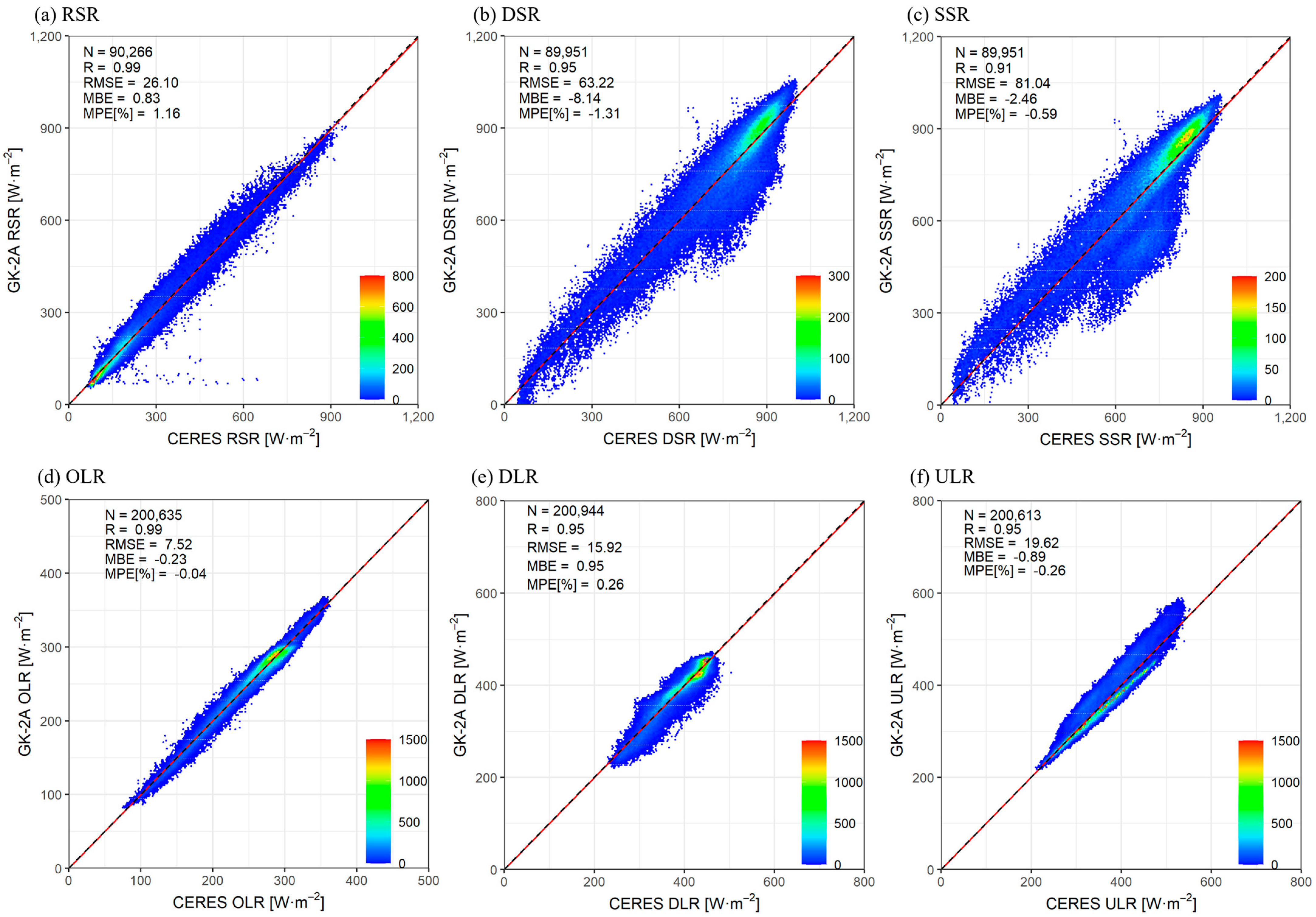
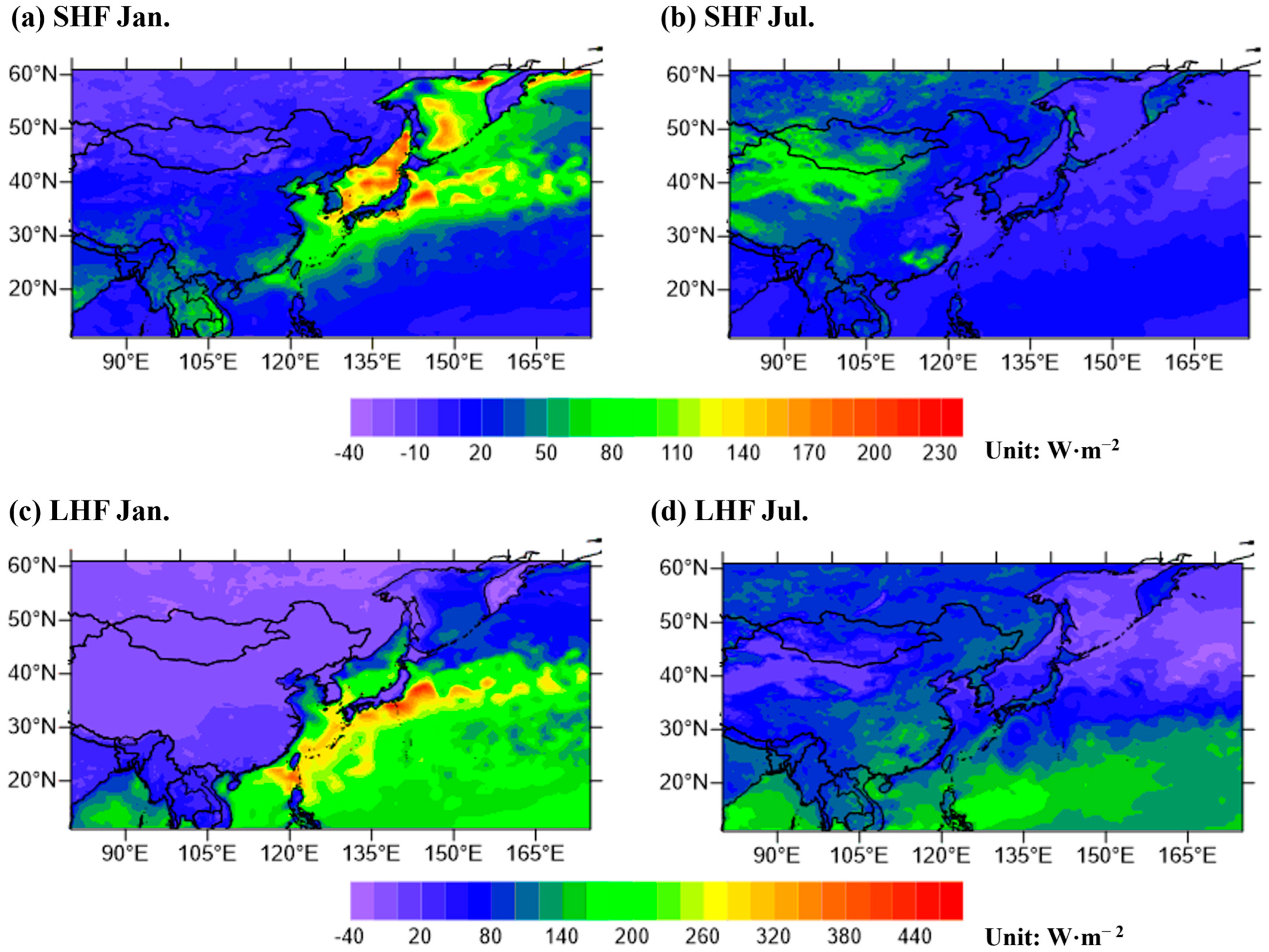
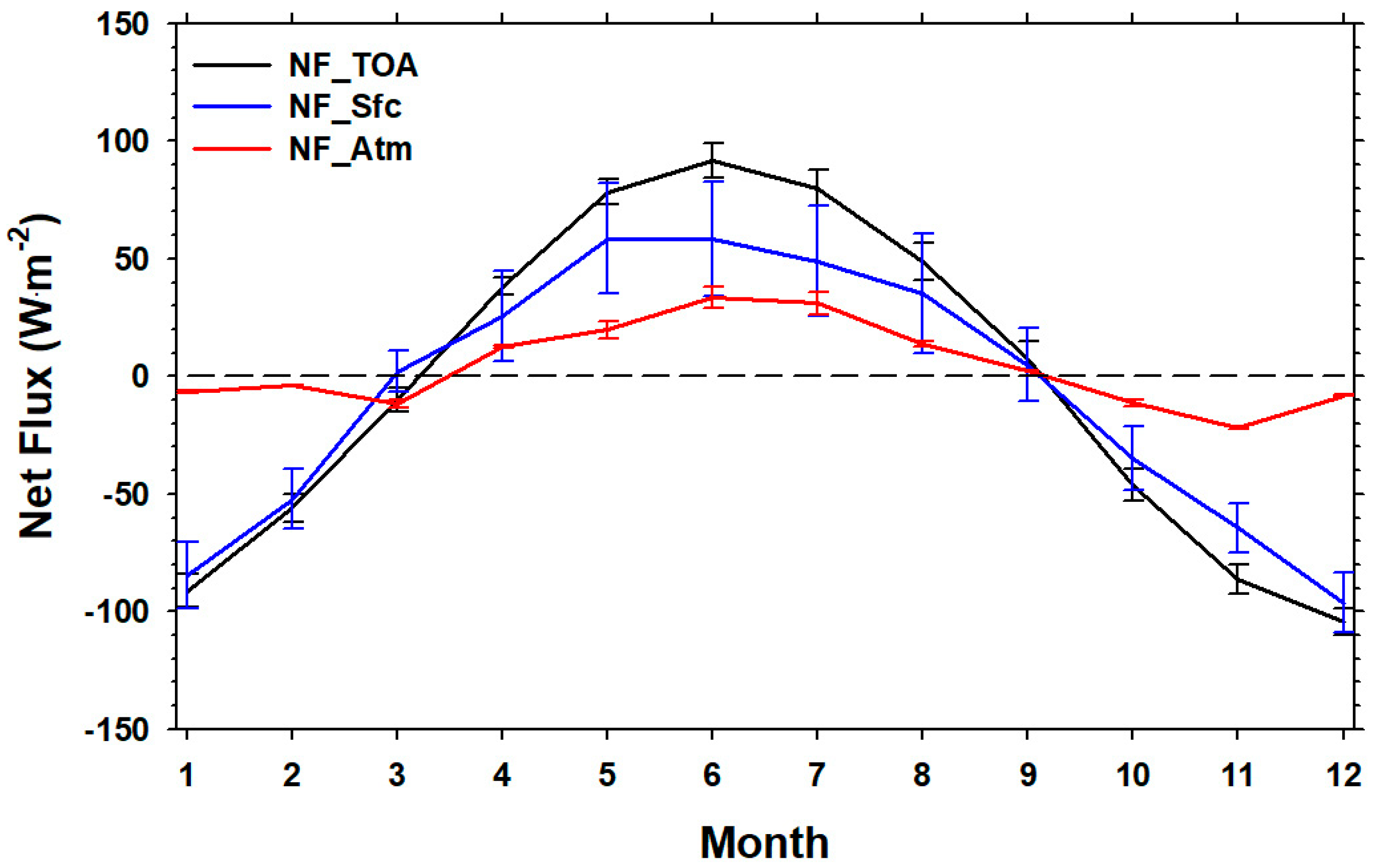
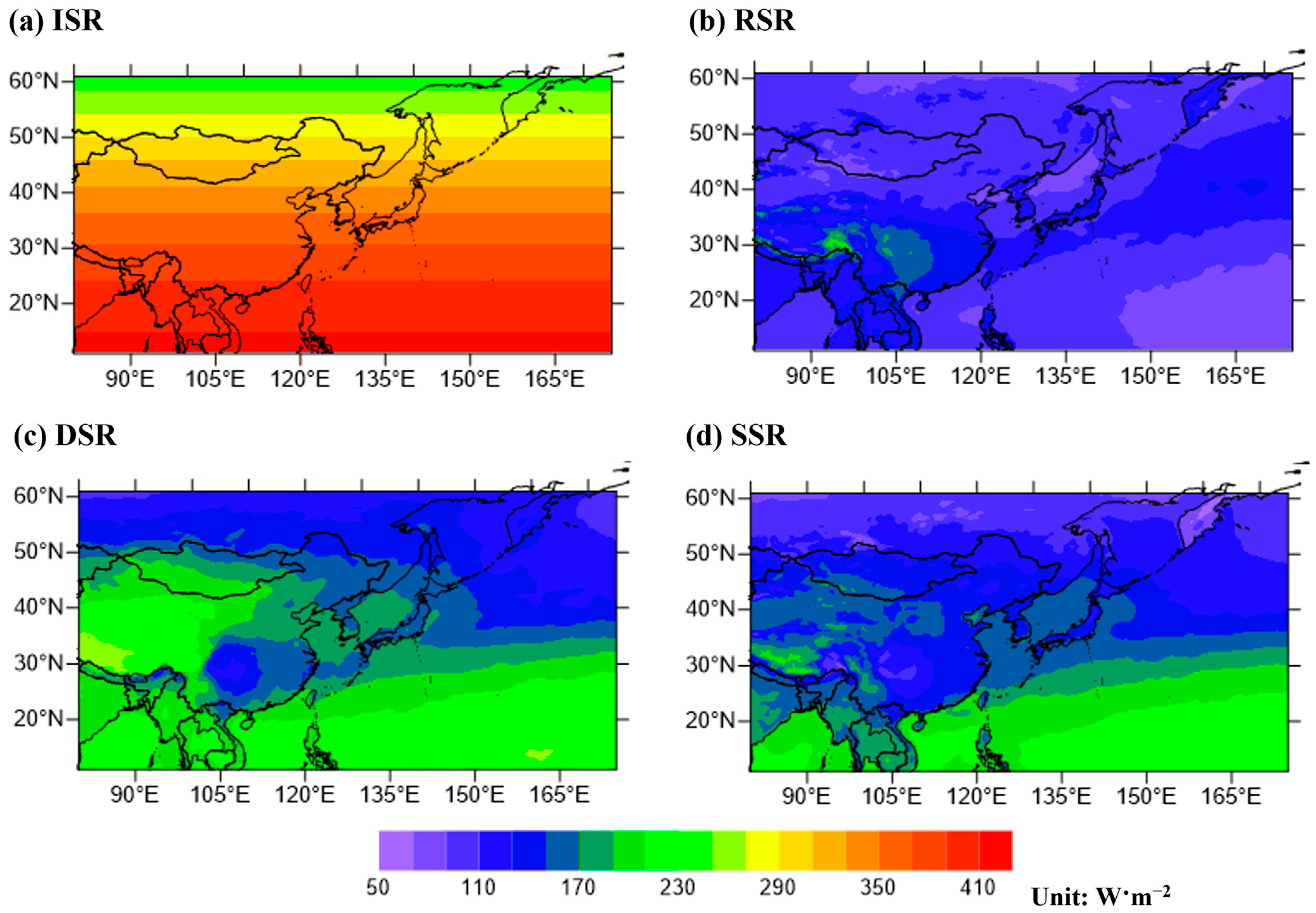
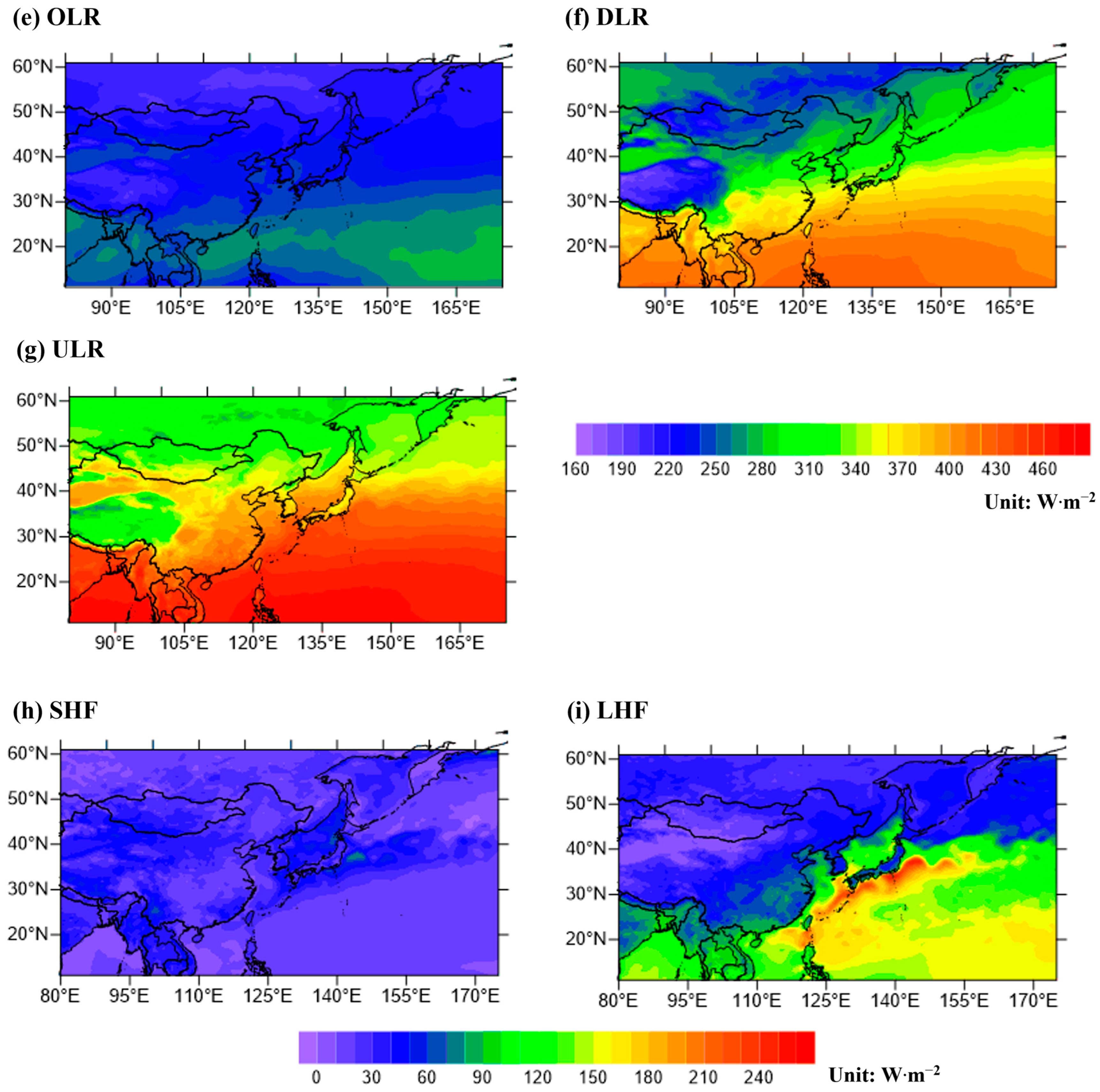
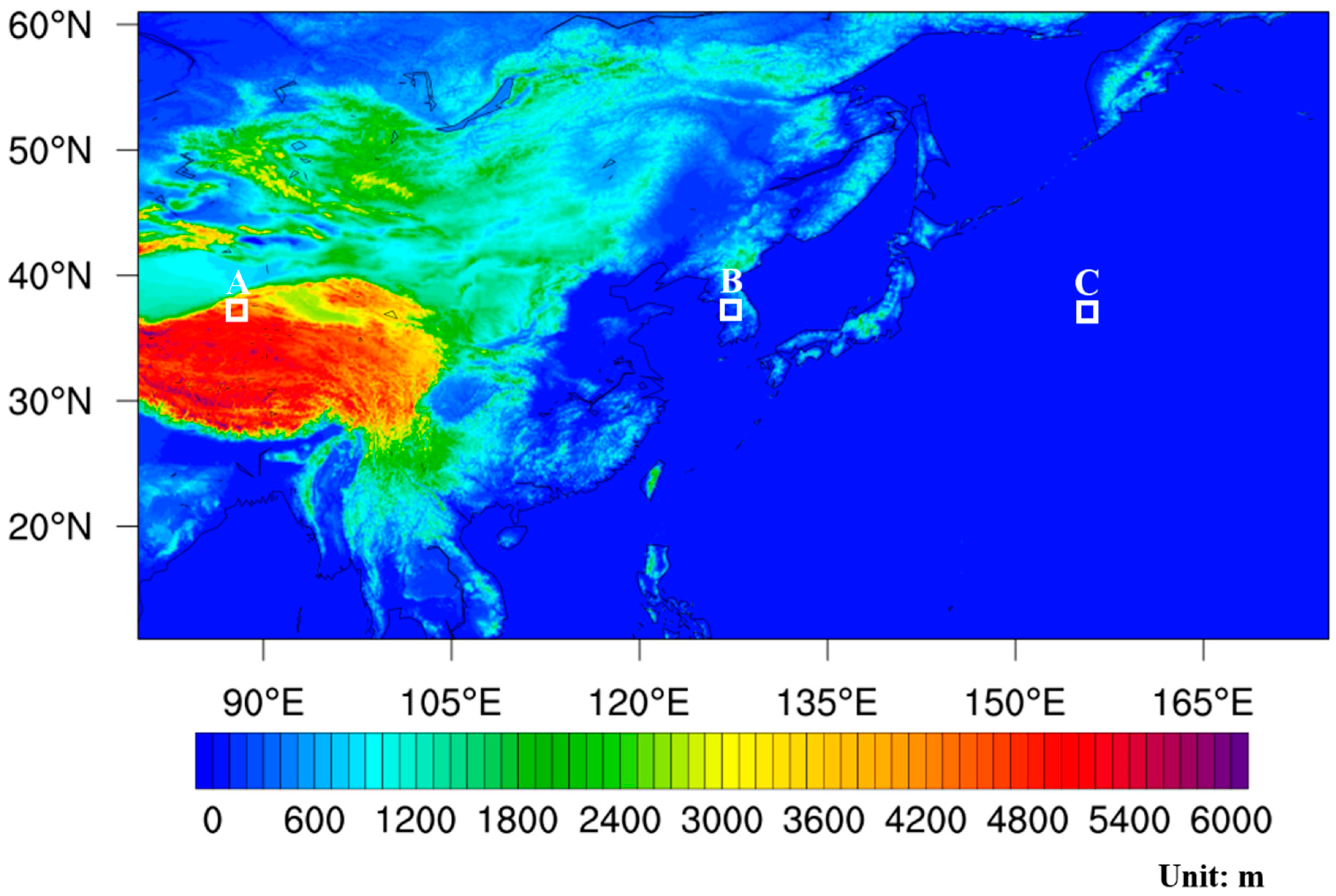

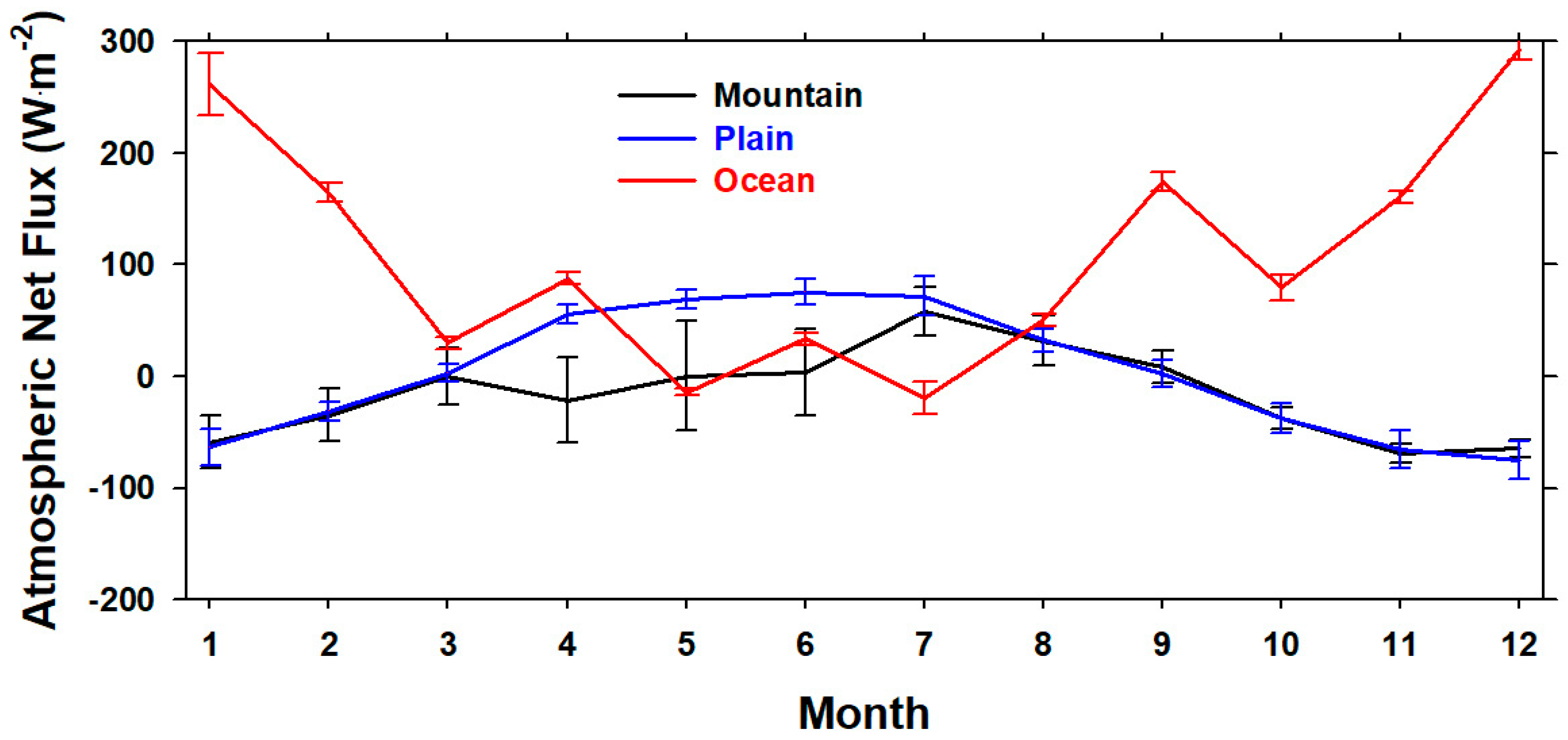
| Channel Number | Channel Name | Wavelength (µm) | Resolution (km) |
|---|---|---|---|
| 1 | VIS (VIS0.4) | 0.4310–0.4790 | 1.0 |
| 2 | VIS (VIS0.5) | 0.5028–0.5175 | 1.0 |
| 3 | VIS (VIS0.6) | 0.6250–0.6600 | 0.5 |
| 4 | VNIR (VIS0.8) | 0.8475–0.8705 | 1.0 |
| 5 | SWIR (NR1.3) | 1.3730–1.3830 | 2.0 |
| 6 | SWIR (NR1.6) | 1.6010–1.6190 | 2.0 |
| 7 | MWIR (IR3.8) | 3.7400–3.9600 | 2.0 |
| 8 | MWIR (IR6.3) | 6.0610–6.4250 | 2.0 |
| 9 | MWIR (IR6.9) | 6.8900–7.0100 | 2.0 |
| 10 | MWIR (IR7.3) | 7.2580–74330 | 2.0 |
| 11 | TIR (IR8.7) | 8.4400–8.7600 | 2.0 |
| 12 | TIR (IR9.6) | 9.5430–9.717 | 2.0 |
| 13 | TIR (IR10.5) | 10.2500–10.6100 | 2.0 |
| 14 | TIR (IR11.2) | 11.0800–11.3200 | 2.0 |
| 15 | TIR (IR12.3) | 12.1500–12.4500 | 2.0 |
| 16 | TIR (IR13.3) | 12.2100–13.3900 | 2.0 |
| Radiative Products | Comparative Data | R | MBE (W·m−2) | MPE (%) |
|---|---|---|---|---|
| RSR | HIMAWARI/AHI | 0.99 | −1.36 | −2.43 |
| CERES EBAF | 0.97 | −3.74 | −5.04 | |
| ERA5 | 0.96 | −3.57 | −5.25 | |
| DSR | HIMAWARI/AHI | 0.99 | −1.99 | 2.01 |
| CERES EBAF | 0.98 | −2.17 | 2.75 | |
| ERA5 | 0.98 | −2.66 | −2.09 | |
| SSR | HIMAWARI/AHI | 0.99 | −0.31 | 0.58 |
| CERES EBAF | 0.98 | −0.49 | 0.71 | |
| ERA5 | 0.98 | −0.53 | 0.70 | |
| OLR | HIMAWARI/AHI | 0.99 | 0.23 | 0.15 |
| CERES EBAF | 0.98 | −0.46 | −0.19 | |
| ERA5 | 0.99 | −0.68 | −0.24 | |
| DLR | HIMAWARI/AHI | 0.99 | 2.58 | 0.79 |
| CERES EBAF | 0.99 | 2.97 | 0.90 | |
| ERA5 | 0.99 | 3.26 | 0.95 | |
| ULR | HIMAWARI/AHI | 0.99 | 0.93 | 0.22 |
| CERES EBAF | 0.99 | 1.52 | 0.44 | |
| ERA5 | 0.99 | 1.74 | 0.48 |
| Season | Radiative Component | Non-Radiative Component (ERA5) | |||||||
|---|---|---|---|---|---|---|---|---|---|
| Shortwave | Longwave | ||||||||
| ISR | RSR | DSR | SSR | OLR | ULR | DLR | SHF | LHF | |
| Spring | 395.66 | 125.39 | 218.32 | 179.16 | 234.70 | 377.91 | 315.51 | 24.13 | 63.87 |
| (395.68) | (128.99) | (220.21) | (179.88) | (235.17) | (376.12) | (313.69) | |||
| Sumer | 452.36 | 140.05 | 225.72 | 200.39 | 238.83 | 426.46 | 373.13 | 21.10 | 78.58 |
| (452.37) | (144.18) | (227.69) | (200.91) | (239.31) | (424.83) | (370.94) | |||
| Autumn | 280.83 | 89.87 | 141.85 | 123.95 | 232.57 | 386.94 | 328.83 | 15.77 | 81.54 |
| (280.85) | (91.16) | (142.74) | (124.29) | (233.04) | (385.31) | (326.84) | |||
| Winter | 213.34 | 70.77 | 114.23 | 95.21 | 226.37 | 337.42 | 276.19 | 23.79 | 87.83 |
| (213.36) | (72.31) | (115.33) | (95.67) | (226.81) | (336.09) | (274.68) | |||
| Mean | 335.55 | 106.52 | 175.03 | 149.68 | 233.12 | 382.18 | 323.42 | 21.20 | 77.96 |
| (335.56) | (109.16) | (176.49) | (150.18) | (233.58) | (380.58) | (321.53) | |||
| Radiative Energy Budget Component | GK-2A/AMI | ERA5 Data |
|---|---|---|
| NF_TOA | −4.09 | −4.01 |
| NF_Atm | −4.15 | −4.05 |
| NLF_Sfc | −8.24 | −8.06 |
Disclaimer/Publisher’s Note: The statements, opinions and data contained in all publications are solely those of the individual author(s) and contributor(s) and not of MDPI and/or the editor(s). MDPI and/or the editor(s) disclaim responsibility for any injury to people or property resulting from any ideas, methods, instructions or products referred to in the content. |
© 2023 by the authors. Licensee MDPI, Basel, Switzerland. This article is an open access article distributed under the terms and conditions of the Creative Commons Attribution (CC BY) license (https://creativecommons.org/licenses/by/4.0/).
Share and Cite
Zo, I.-S.; Jee, J.-B.; Lee, K.-T.; Lee, K.-H.; Lee, M.-Y.; Kwon, Y.-S. Radiative Energy Budget for East Asia Based on GK-2A/AMI Observation Data. Remote Sens. 2023, 15, 1558. https://doi.org/10.3390/rs15061558
Zo I-S, Jee J-B, Lee K-T, Lee K-H, Lee M-Y, Kwon Y-S. Radiative Energy Budget for East Asia Based on GK-2A/AMI Observation Data. Remote Sensing. 2023; 15(6):1558. https://doi.org/10.3390/rs15061558
Chicago/Turabian StyleZo, Il-Sung, Joon-Bum Jee, Kyu-Tae Lee, Kwon-Ho Lee, Mi-Young Lee, and Yong-Soon Kwon. 2023. "Radiative Energy Budget for East Asia Based on GK-2A/AMI Observation Data" Remote Sensing 15, no. 6: 1558. https://doi.org/10.3390/rs15061558
APA StyleZo, I.-S., Jee, J.-B., Lee, K.-T., Lee, K.-H., Lee, M.-Y., & Kwon, Y.-S. (2023). Radiative Energy Budget for East Asia Based on GK-2A/AMI Observation Data. Remote Sensing, 15(6), 1558. https://doi.org/10.3390/rs15061558







